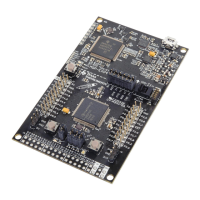18 Examples for TI-RTOS SPRUHU4D—February 2016
Submit Documentation Feedback
Creating Examples with IAR Embedded Workbench www.ti.com
3.2 Creating Examples with IAR Embedded Workbench
For information about using TI-RTOS examples with IAR Embedded Workbench, see the wiki page on
Creating TI-RTOS Applications in IAR Embedded Workbench on the Texas Instruments wiki.
3.3 Driver Examples: Readme Files and Common Features
Details about the driver examples are provided in the readme files in the example projects. There is a
separate <example_name>_readme file for each of the examples. These files are added to your CCS
project when you use the Resource Explorer to create a project. You can open the
<example_name>_readme file within CCS. The <example_name>_readme files contain the following
types of information:
•
Actions performed by functions in the example.
•
Hardware-specific descriptions of buttons, LEDs, etc…
•
Which external components are (or may be) needed to run with particular examples.
There are several TI-RTOS example categories. The Empty and Empty (Minimal) projects are configured
to make TI-RTOS available but do not contain specific code that uses TI-RTOS. The Demo examples use
several peripherals working together. The remaining examples show how to use a specific peripheral.
The Driver Examples share the following features:
•
Most TI-RTOS driver examples use the SysMin System Support module. See the readme files in the
individual example projects for details.
•
The empty, demo, and most UART examples use the ti.uia.sysbios.LoggingSetup module with stop
mode data collection. The UART Console example uses run-time data collection during Idle thread
processing. For more details on data collection, see Chapter 2 of the TI-RTOS User’s Guide
(SPRUHD4).
•
Driver Examples for a particular target all have the same <board>.c and <board>.h files. These files
perform board-specific configuration of the drivers provided by TI-RTOS. For more details, see
Chapter 4 of the TI-RTOS User’s Guide (SPRUHD4).
The sections that follow list settings required to run the TI-RTOS examples on the supported boards.
They also list the hardware resources that TI-RTOS and its dependent components use by default. Some
of these resources offer flexible options, whereas others are fixed in the current design or
implementation.

